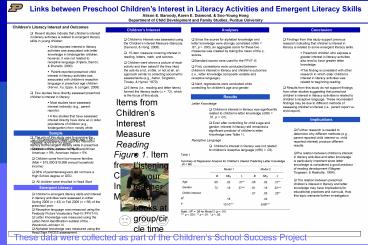Links between Preschool Childrens Interest in Literacy Activities and Emergent Literacy Skills - PowerPoint PPT Presentation
1 / 1
Title:
Links between Preschool Childrens Interest in Literacy Activities and Emergent Literacy Skills
Description:
Child-reported interest in literacy activities was associated with letter ... using the Letter-Word Identification subtest of the Woodcock-Johnson III. ... – PowerPoint PPT presentation
Number of Views:49
Avg rating:3.0/5.0
Title: Links between Preschool Childrens Interest in Literacy Activities and Emergent Literacy Skills
1
Links between Preschool Childrens Interest in
Literacy Activities and Emergent Literacy
Skills Alison E. Baroody, Karen E. Diamond,
Soo-Young Hong Department of Child Development
and Family Studies, Purdue University
- Childrens Literacy Interest and Outcomes
- Recent studies indicate that childrens
interest in literacy activities is related to
emergent literacy skills in young children. - Child-reported interest in literacy activities
was associated with letter knowledge in
kindergarten children however, it was not
related to receptive language (Frijters, Barron,
Brunello, 2000). - Parent-reported preschool child interest in
literacy activities was associated with
childrens receptive language in preschool age
children (Farver, Xu, Eppe, Lonigan, 2006) - Few studies have directly assessed preschool
childrens interest in literacy. - Most studies have assessed interest indirectly
(e.g., parent reports). - A few studies that have assessed interest
directly have done so in older populations of
children (e.g., kindergarten) from mostly white
middle-class families. - The aim of this study was to examine the
relationship between child-reported interest in
literacy and emergent literacy skills in
preschool children from low-income families.
Childrens Interest
Analyses
Conclusion
- Since the scores for alphabet knowledge and
letter knowledge were strongly correlated (r(96)
.87, p lt .000), an aggregate score for these
two measures was created by taking the mean of
the z-scores. - Standard scores were used for the PPVT-III.
- First, correlations were conducted between
childrens interest in literacy and childrens
outcomes (i.e., letter knowledge composite
variable and receptive language). - Next, regressions were conducted while
controlling for childrens age and gender.
- Findings from this study support previous
research indicating that childrens interest in
literacy is related to some emergent literacy
skills. - Preschool children who express a greater
interest in literacy activities also tend to have
greater letter knowledge. - This finding is consistent with other research in
which older childrens interest in literacy
activities was related to beginning reading. - Results from this study do not support findings
from other studies suggesting that preschool
childrens interest in literacy activities is
related to childrens receptive language. These
inconsistent findings may be due to different
methods of assessing childrens interest (i.e.,
parent report vs. child report).
- Childrens Interest was assessed using the
Childrens Interest Measure (Baroody, Diamond,
Hong, 2006). - 15-item measure covering interest in reading,
letters, math, and science. - Children were shown a picture of each activity
and then asked if the they liked the activity a
lot, a little, or not at all, an approach similar
to collecting sociometric assessments (e.g.,
Asher, Singleton, Tinsley, Hymel, 1979) - 6 items (i.e., reading and letter items) formed
the literacy scale (? .72), which is the focus
of this study.
Results
- Items from Childrens Interest Measure
- Reading
- Listening to your teacher read books at
group/circle time - Reading books
- Looking at books in the library/book corner
during choice time - Letters
- Learning about names of letters
- Learning about words that rhyme
- Learning the sounds that letters make
Implications
- Further research is needed to determine why
different methods (e.g., parent reported child
interest vs. child reported interest) produce
different results. - The relation between childrens interest in
literacy activities and letter knowledge is
particularly important since letter knowledge is
considered a good predictor of reading
development (Wagner, Torgesen, Rashotte, 1994). - The relation between preschool childrens
interest in literacy and letter knowledge may
have implications for educational practices and
curricula, thus this topic warrants further
investigation.
- 100 preschool children (mean age 58.7 months,
SD 5.1, 51 boys) - White 69, Latino 17, Black/African
American 9, American Indian 5. - Children came from low-income families (Mdn
15,000-19,999 annual household income) - 36 of parents/caregivers did not have a High
School degree or GED. - All children were enrolled in Head Start or
local child care centers
Sample
Figure 1. Item from the Childrens Interest
Measure Reading books.
Emergent Literacy
- Childrens emergent literacy skills and interest
in literacy activities were assessed in either
Spring 2006 (n 42) or Fall 2006 (n 58) of the
preschool year. - Receptive language was measured using the
Peabody Picture Vocabulary Test-III (PPVT-III). - Letter Knowledge was measured using the
Letter-Word Identification subtest of the
Woodcock-Johnson III. - Alphabet knowledge was measured using the Head
Start FACES assessment.
These data were collected as part of the
Childrens School Success Project (CSS Odom,
Butera, Diamond, Hanson, Horn, Lieber, Palmer,
2003 )

